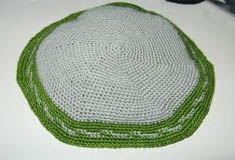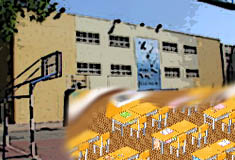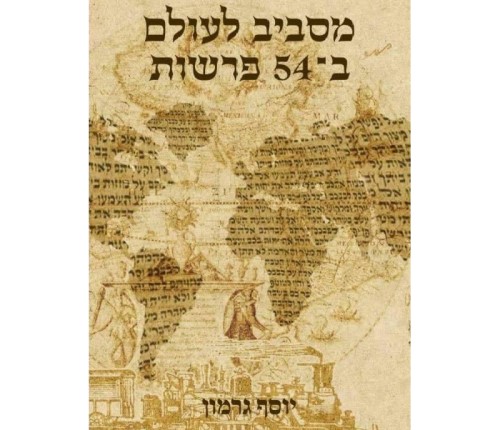Securing Identity: Navigating Concealment in Challenging Times
הרב שי טחןכה שבט, תשפד04/02/2024When times become challenging, and anti-Semitism rears its ugly head in various parts of the world, Jewish individuals often choose to conceal their Jewish symbols...
תגיות:אנטישמיותיהדותסימנים
When times become challenging, and anti-Semitism rears its ugly head in various parts of the world, Jewish individuals often choose to conceal their Jewish symbols to mitigate potential risks and avoid attacks. Let's address a few questions and explore the guidance provided by Halacha on this matter.
Let's commence our discussion with the halacha (יו״ד סימן קנז) that whenever Jews face persecution and are compelled to violate any Jewish law or remove any Jewish sign, even if it pertains to a Jewish custom such as wearing specific shoelaces, they may not comply. Even if a non-Jew threatens to kill them for non-compliance, the halacha dictates that one should choose martyrdom rather than violate the minhag (יהרג ואל יעבור).
they may not comply. Even if a non-Jew threatens to kill them for non-compliance, the halacha dictates that one should choose martyrdom rather than violate the minhag (יהרג ואל יעבור).
Accordingly, we can conclude that removing the Mezuzah or kipa in a place of danger should be prohibited. However, it is important to note that this obligation is primarily applicable in situations of persecution, where non-Jews attempt to force conversion or openly command violations of Jewish tradition. In a scenario where it is merely dangerous to be around non-Jews with these Jewish symbols, it is permitted to conceal them.
Mezuzah Placement in High-Risk Locations.
As the Mezuzah on the door is the most conspicuous indication that a Jewish individual resides in a house, in certain locations around the world, Jews have opted to remove the Mezuzah from their front doors. Is that permitted?
The Halacha openly addresses a scenario where partners share a house, one being Jewish and the other a gentile. The Rema(סימן רפו ס״א) notes that such a house is exempt from having a Mezuzah. Among the reasons provided for this exemption, some suggest(ש״ך) that it is due to the potential danger that the gentile partner might suspect the Jewish partner of engaging in supernatural practices with the Mezuzah, potentially leading to harm against the Jew.
The Meiri (יומא יא,א) explains that Hashem does not desire a person to expose themselves to danger and rely on miracles for the fulfillment of the Mitsvot. Similarly, it is written in the responsa "Chikrei Lev" (סימן קכט) that the Torah did not command the placement of a Mezuzah for the sake of potential harm. The Shach (ש״ך סק״ז) writes that throughout the exile the Jewish ghetto’s gates were exempt, as they were prone to non-Jewish hostility in those locations.
According to these considerations, there certainly would have been grounds to exempt the residences in a dangerous area to prevent harm to property and life. However, there is a distinction between the case discussed above and today’s situation. In a house shared with a non-Jew, it is not possible to affix a Mezuzah at all, as the non-Jew would see the Mezuzah both upon entering and exiting. Nevertheless, in a location where non-Jews only pass from the outside, one can place the Mezuzah in the inner part of the entrance, visible from within the house but not from outside. Even though our Sages established (הובא בשולחן ערוך סימן רפט ס״ב) that its fixed position should be within a handbreadth of the outside (טפח החיצון) to immediately encounter the Mezuzah upon entering, and to safeguard the entire house from harmful entities, this is merely an ideal practice, but in time of danger, one can place it more internally.
For those unable to affix the Mezuzah on the inner part of the entrance, an alternative is to carve into the doorpost and place the Mezuzah inside, concealing it from view. However, it's crucial to note that the Mezuzah should not be deeper than a hand breadth(טפח) . While some poskim(יד הקטנה הובא בפת״ש סימן רפט) contend that if the Mezuzah is entirely invisible, one might not fulfill the obligation, as by placing the Mezuzah in a concealed manner, the intended purpose of the Mezuzah—to serve as a constant reminder of Hashem's presence when entering or leaving the house (Rambam)—is compromised, as its visibility is crucial for fulfilling this function. Still the majority poskim assert that while it's not the ideal way, the mitzvah is still considered fulfilled. (בן איש חי ש״ב פרשת כי תבוא אות יד, ערוך השולחן)
Removing the Kipa in Vulnerable Environments.
Another conspicuous sign of a man being Jewish is the kipa. In a place where one might fear for his safety, the best course of action is to wear a hat, as it will cover the kipa. But what should one do if he finds himself in a dangerous place without a hat? Should he remove the kipa? This becomes particularly relevant, for example, when driving from Brooklyn to Manhattan and, upon reaching the Brooklyn Bridge, encountering a large and violent Palestinian rally. In such a tumultuous situation, should he remove the kipa to avoid drawing attention to his Jewish identity?
Let's first explore the obligation to wear a kipa. The Talmud(שבת קנו,ב) states that covering the head aids a person in acquiring Yirat Shamayim—the fear of Hashem. Maimonides ( הלכות דעות פ״ה ה״ו Rambam) further elucidates that it is a manifestation of tsniut—modesty. The rationale is that when one wears a kipa, he senses a higher presence above him, prompting him to conduct himself with greater modesty and mindfulness of his actions compared to someone without a tangible reminder(רמב״ם מורה נבוכים ח״ג פרק נב) .
Many poskim (אגר״מ ח״ד ס״ב ויבי״א ח״ט ס״א) maintain that according to the aforementioned opinions, wearing a kipa is considered a Midat Chasidut (מידת חסידות), an act of piety, and stringency, but it is not deemed obligatory. However, the Taz (סימן ח סק״ג) notes that in contemporary times, as non-Jews often go without head coverings, wearing a kipa also serves to distinguish the Jewish nation from others (בחוקותיהם לא תלכו). Contemporary poskim (יבי״א ח״ט ס״א) assert that today the obligation to wear a kipa is even more pronounced. It serves to delineate the distinction between God-fearing Jews who believe in Hashem and those who do not. In the present context, it becomes essential not to appear as someone who lacks fear of God.
Returning to our discussion, Rabbi Moshe Feinstein was asked about someone seeking employment at a place where wearing a kipa would not be feasible. He responded that based on the poskim who consider wearing a kipa a stringency and not an obligation; one may go without head covering in a situation where finding alternative employment would be challenging. In light of this, it is certainly permissible in life-threatening situations not to place oneself at risk.
Next week, we will continue, with Hashem's help, the discussion on when one should consider a scenario dangerous and when one should not. We will also explore what one should do if asked directly about their Jewish identity in a perilous environment.
Let's commence our discussion with the halacha (יו״ד סימן קנז) that whenever Jews face persecution and are compelled to violate any Jewish law or remove any Jewish sign, even if it pertains to a Jewish custom such as wearing specific shoelaces,

Accordingly, we can conclude that removing the Mezuzah or kipa in a place of danger should be prohibited. However, it is important to note that this obligation is primarily applicable in situations of persecution, where non-Jews attempt to force conversion or openly command violations of Jewish tradition. In a scenario where it is merely dangerous to be around non-Jews with these Jewish symbols, it is permitted to conceal them.
Mezuzah Placement in High-Risk Locations.
As the Mezuzah on the door is the most conspicuous indication that a Jewish individual resides in a house, in certain locations around the world, Jews have opted to remove the Mezuzah from their front doors. Is that permitted?
The Halacha openly addresses a scenario where partners share a house, one being Jewish and the other a gentile. The Rema(סימן רפו ס״א) notes that such a house is exempt from having a Mezuzah. Among the reasons provided for this exemption, some suggest(ש״ך) that it is due to the potential danger that the gentile partner might suspect the Jewish partner of engaging in supernatural practices with the Mezuzah, potentially leading to harm against the Jew.
The Meiri (יומא יא,א) explains that Hashem does not desire a person to expose themselves to danger and rely on miracles for the fulfillment of the Mitsvot. Similarly, it is written in the responsa "Chikrei Lev" (סימן קכט) that the Torah did not command the placement of a Mezuzah for the sake of potential harm. The Shach (ש״ך סק״ז) writes that throughout the exile the Jewish ghetto’s gates were exempt, as they were prone to non-Jewish hostility in those locations.
According to these considerations, there certainly would have been grounds to exempt the residences in a dangerous area to prevent harm to property and life. However, there is a distinction between the case discussed above and today’s situation. In a house shared with a non-Jew, it is not possible to affix a Mezuzah at all, as the non-Jew would see the Mezuzah both upon entering and exiting. Nevertheless, in a location where non-Jews only pass from the outside, one can place the Mezuzah in the inner part of the entrance, visible from within the house but not from outside. Even though our Sages established (הובא בשולחן ערוך סימן רפט ס״ב) that its fixed position should be within a handbreadth of the outside (טפח החיצון) to immediately encounter the Mezuzah upon entering, and to safeguard the entire house from harmful entities, this is merely an ideal practice, but in time of danger, one can place it more internally.
For those unable to affix the Mezuzah on the inner part of the entrance, an alternative is to carve into the doorpost and place the Mezuzah inside, concealing it from view. However, it's crucial to note that the Mezuzah should not be deeper than a hand breadth(טפח) . While some poskim(יד הקטנה הובא בפת״ש סימן רפט) contend that if the Mezuzah is entirely invisible, one might not fulfill the obligation, as by placing the Mezuzah in a concealed manner, the intended purpose of the Mezuzah—to serve as a constant reminder of Hashem's presence when entering or leaving the house (Rambam)—is compromised, as its visibility is crucial for fulfilling this function. Still the majority poskim assert that while it's not the ideal way, the mitzvah is still considered fulfilled. (בן איש חי ש״ב פרשת כי תבוא אות יד, ערוך השולחן)
Removing the Kipa in Vulnerable Environments.
Another conspicuous sign of a man being Jewish is the kipa. In a place where one might fear for his safety, the best course of action is to wear a hat, as it will cover the kipa. But what should one do if he finds himself in a dangerous place without a hat? Should he remove the kipa? This becomes particularly relevant, for example, when driving from Brooklyn to Manhattan and, upon reaching the Brooklyn Bridge, encountering a large and violent Palestinian rally. In such a tumultuous situation, should he remove the kipa to avoid drawing attention to his Jewish identity?
Let's first explore the obligation to wear a kipa. The Talmud(שבת קנו,ב) states that covering the head aids a person in acquiring Yirat Shamayim—the fear of Hashem. Maimonides ( הלכות דעות פ״ה ה״ו Rambam) further elucidates that it is a manifestation of tsniut—modesty. The rationale is that when one wears a kipa, he senses a higher presence above him, prompting him to conduct himself with greater modesty and mindfulness of his actions compared to someone without a tangible reminder(רמב״ם מורה נבוכים ח״ג פרק נב) .
Many poskim (אגר״מ ח״ד ס״ב ויבי״א ח״ט ס״א) maintain that according to the aforementioned opinions, wearing a kipa is considered a Midat Chasidut (מידת חסידות), an act of piety, and stringency, but it is not deemed obligatory. However, the Taz (סימן ח סק״ג) notes that in contemporary times, as non-Jews often go without head coverings, wearing a kipa also serves to distinguish the Jewish nation from others (בחוקותיהם לא תלכו). Contemporary poskim (יבי״א ח״ט ס״א) assert that today the obligation to wear a kipa is even more pronounced. It serves to delineate the distinction between God-fearing Jews who believe in Hashem and those who do not. In the present context, it becomes essential not to appear as someone who lacks fear of God.
Returning to our discussion, Rabbi Moshe Feinstein was asked about someone seeking employment at a place where wearing a kipa would not be feasible. He responded that based on the poskim who consider wearing a kipa a stringency and not an obligation; one may go without head covering in a situation where finding alternative employment would be challenging. In light of this, it is certainly permissible in life-threatening situations not to place oneself at risk.
Next week, we will continue, with Hashem's help, the discussion on when one should consider a scenario dangerous and when one should not. We will also explore what one should do if asked directly about their Jewish identity in a perilous environment.
הוסף תגובה
עוד מהרב שי טחן
עוד בנושא עם וארץ ישראל







